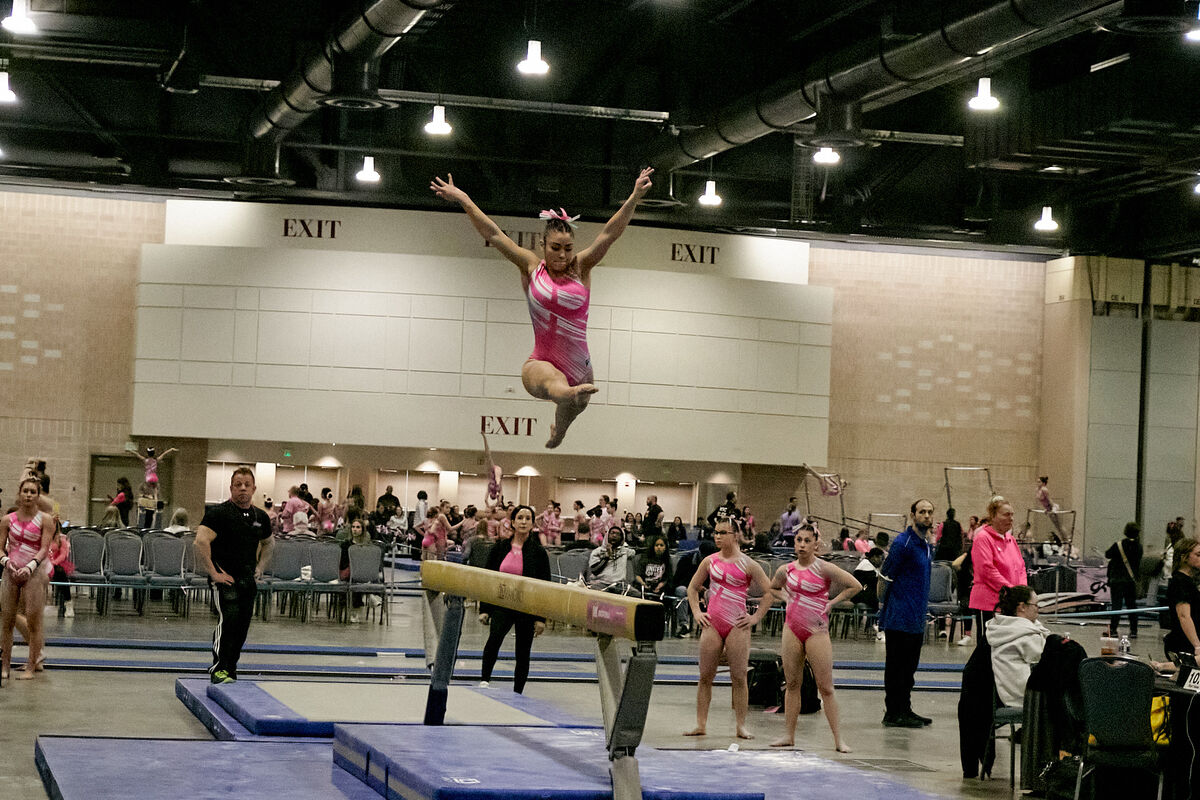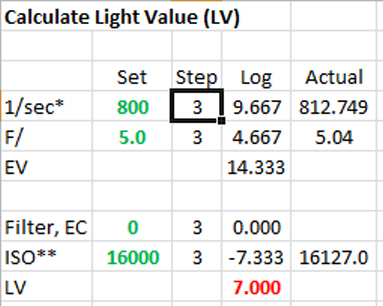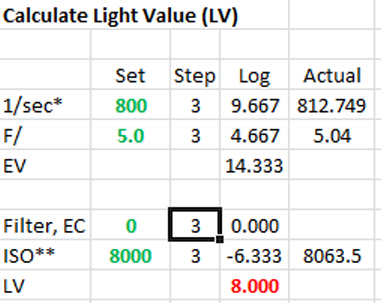Affinity Problem (Help)
Feb 28, 2024 09:42:45 #
Ysarex wrote:
No. The -1 EC would alter the camera selected exposure whereas engaging the HTP function would not alter the camera selected exposure. Using a minus EC would reduce exposure while engaging HTP would not reduce exposure. You are wrong.
selmslie wrote:
We can replicate Canon's approach by setting the camera to Evaluative metering and exposure compensation to -1.
No. The -1 EC would alter the camera selected exposure whereas engaging the HTP function would not alter the camera selected exposure. Using a minus EC would reduce exposure while engaging HTP would not reduce exposure. You are wrong.
I'm not surprised that my earlier explanation confused you. I should have mentioned that you would be using the real ISO instead of the fake one, one stop below the one that's dialed in.
If the camera's base ISO is 100, the lowest ISO you can set manually is 200 with HTP turned on. And Auto Lighting Optimizer is disabled. The camera then records the raw file as if it were set to ISO 100 and underexposed by one stop (EC-1). It then reverses the process when it creates the JPEG so it looks like it was shot at ISO 200.
The OP's original raw file shows it was taken at ISO 16000 but the raw file recorded it as if it were ISO 8000. It then brightened the result by one stop for the camera's JPEG but Affinity did not know about that trick. The raw highlights are not as blown out but the JPEG highlights are just as blown out because of the boost in brightness.
But Capture One knwe about HTP since, when I clicked on Auto Adjust Exposure the result was only a 0.16 stop boost, not 1.16
As I mentioned earlier, HTP is not designed for situations where the highlights are light sources. It's for situations where the highlights are just about 1 stop from blowing out in the raw file. That's totally different from this example.
The result doesn't look bad using Capture One default exposure adjustments and no noise reduction.

(Download)
Feb 28, 2024 10:09:33 #
Ysarex
Loc: St. Louis
selmslie wrote:
I'm not surprised that my earlier explanation confused you. I should have mentioned that you would be using the real ISO instead of the fake one, one stop below the one that's dialed in.
ISO is not a determinant exposure factor (shutter speed, aperture, scene luminance) and you're still wrong.
The OP took his photo at ISO 1600 and the camera's Evaluative metering calculated an exposure of 1/800 sec. f/5.0 with HTP set ON. If instead he had turned HTP OFF and set a -1 EC the camera's meter would have calculated a reduced exposure of 1/1600 sec. f/5.0 (camera set Aperture priority). Using a -1 EC does not replicate the action of the HTP function. You are wrong.
Feb 28, 2024 10:10:03 #
Feb 28, 2024 10:13:19 #
Ysarex
Loc: St. Louis
foathog wrote:
Inotherwords, get rid of Affinity?
AP is an excellent raster editor at a great price. It's raw file processing component needs work. Use a different raw processor to generate an RGB file and AP is excellent software to further process that RGB file.
Feb 28, 2024 10:30:20 #
Ysarex wrote:
ISO is not a determinant of exposure and you're still wrong.
It most certainly is when you are using Evaluative metering. If you change the ISO, the exposure will change accordingly.
Ysarex wrote:
The OP took his photo at ISO 1600 and the camera's Evaluative metering calculated an exposure of 1/800 sec. f/5.0 with HTP set ON. If instead he had turned HTP off and set a -1 EC the camera's meter would have calculated a reduced exposure of 1/1600 sec. f/5.0 (camera set Aperture priority). Using a -1 EC does not replicate the action of the HTP function. You are wrong.
You can't read the EXIF information?
 The ISO was set to 16000, not 1600. The result indicates that the light value (LV) was 7. But to account for the fake ISO setting, it might have been 8.
The ISO was set to 16000, not 1600. The result indicates that the light value (LV) was 7. But to account for the fake ISO setting, it might have been 8.So you are wrong twice in the same post. You need to get yourself under control.


Feb 28, 2024 11:12:48 #
Ysarex
Loc: St. Louis
selmslie wrote:
It most certainly is when you are using Evaluative metering. If you change the ISO, the exposure will change accordingly.
That's beside the point. You didn't say anything about the user changing the ISO. You said (in reference to Canon's HTP): "We can replicate Canon's approach by setting the camera to Evaluative metering and exposure compensation to -1."
That is wrong. Here again without my typo (my bad):
The OP took his photo at ISO 16000 and the camera's Evaluative metering calculated an exposure of 1/800 sec. f/5.0 with HTP set ON. If instead he had turned HTP OFF and set a -1 EC the camera's meter would have calculated a reduced exposure of 1/1600 sec. f/5.0 (camera set Aperture priority). Using a -1 EC does not replicate the action of the HTP function. You are wrong.
Feb 28, 2024 11:37:15 #
Ysarex wrote:
That's beside the point. You didn't say anything about the user changing the ISO. You said (in reference to Canon's HTP): "We can replicate Canon's approach by setting the camera to Evaluative metering and exposure compensation to -1."
It's not beside the point. It is the point!
With Evaluative metering (or matrix or multi or multi segment), if you change only the ISO the exposure will change accordingly. The same thing that happens if you change only the EC.
It's not surprising that this concept would elude you because you don't like the name "exposure triangle". The rest of us have no problem following this logic.
Canon's HTP just confuses the issue by applying a double adjustment, one to the raw file and then another one to the JPEG to offset it.
Feb 28, 2024 11:54:25 #
Ysarex
Loc: St. Louis
selmslie wrote:
It's not beside the point. It is the point!
With Evaluative metering (or matrix or multi or multi segment), if you change only the ISO the exposure will change accordingly. The same thing that happens if you change only the EC.
With Evaluative metering (or matrix or multi or multi segment), if you change only the ISO the exposure will change accordingly. The same thing that happens if you change only the EC.
ONE MORE TIME. You said (in reference to Canon's HTP): "We can replicate Canon's approach by setting the camera to Evaluative metering and exposure compensation to -1." That is wrong.
Here's your post: https://www.uglyhedgehog.com/t-800715-3.html#14479827 in which you make no mention of ISO. You remain wrong.
Feb 28, 2024 11:57:39 #
Ysarex wrote:
ONE MORE TIME. You said (in reference to Canon's HTP): "We can replicate Canon's approach by setting the camera to Evaluative metering and exposure compensation to -1." That is wrong.
Here's your post: https://www.uglyhedgehog.com/t-800715-3.html#14479827 in which you make no mention of ISO. You remain wrong.
Here's your post: https://www.uglyhedgehog.com/t-800715-3.html#14479827 in which you make no mention of ISO. You remain wrong.
I guess you don’t really understand the raw process. Otherwise you would not be arguing.
Feb 28, 2024 12:52:16 #
Ysarex
Loc: St. Louis
selmslie wrote:
I guess you don’t really understand the raw process. Otherwise you would not be arguing.
I'm not arguing, I'm just correcting your errors. Let's do a recap on those.
In your first post you made this mistake: "Canon's Highlight Tone Priority is similar to Nikon's Highlight Weighted Metering and Sony's Highlight metering mode. They all adjust the exposure to limit the overexposed highlights."
HTP does not adjust exposure. You were wrong.
You then made it a lot worse by claiming this: "Evaluative metering would have let them blow out more and lightened the raw data by giving less weight to the highlights. This would have called for a lower shutter speed or a wider aperture."
Again HTP does not adjust exposure. With HTP OFF the OP would have gotten the same exposure. You were wrong.
After getting corrected you posted a reference to EOS magazine which does a fair job of explaining how HTP works and in fact notes that it does not alter exposure: "When you enable HTP, the camera will still meter the scene at ISO 400 and still select the same shutter speed and aperture as before."
But even after I assume you read the article you said this this: "You [me] recognize that there is a JPEG adjustment but the "permanent effect on the raw file" is only the result of the change in exposure." https://www.uglyhedgehog.com/t-800715-2.html#14479149 Wrong again after just reading you were wrong! There is no change in exposure. HTP doesn't change the exposure.
Then you started your usual change-the-subject-to-disguise-your-errors shtick and when you were called on that and directed back to the OP's question by SRT101fan you tried to take credit for correctly answering the OP's question. https://www.uglyhedgehog.com/t-800715-3.html#14479511 How juvenile!
After more failed attempts to change the subject you then posted this error: https://www.uglyhedgehog.com/t-800715-3.html#14479827 "We can replicate Canon's approach by setting the camera to Evaluative metering and exposure compensation to -1." Wrong again. A minus EC will cause a change in exposure but the HTP function does not change exposure. You even posted an article that makes that clear. Wow! You're actually tripling down on your mistake even after you posted an article that makes it clear that you are wrong. HTP does not adjust or change the exposure.
Feb 28, 2024 13:08:35 #
It’s really about how to replicate what Canon did.
The point is that what they did can be replicated in the raw file by lowering only the ISO without changing the exposure. You can get the same effect in the raw file lowering only the EC which changes the exposure.
But what Canon did was a kludge to alter the raw file and offset that with a change in the JPEG creation. It’s still a dumb solution and it should be avoided.
The point is that what they did can be replicated in the raw file by lowering only the ISO without changing the exposure. You can get the same effect in the raw file lowering only the EC which changes the exposure.
But what Canon did was a kludge to alter the raw file and offset that with a change in the JPEG creation. It’s still a dumb solution and it should be avoided.
Feb 28, 2024 13:28:17 #
Ysarex
Loc: St. Louis
selmslie wrote:
It’s really about how to replicate what Canon did.
The point is that what they did can be replicated in the raw file by lowering only the ISO without changing the exposure.
The point is that what they did can be replicated in the raw file by lowering only the ISO without changing the exposure.
That is not what you said. You said, "We can replicate Canon's approach by setting the camera to Evaluative metering and exposure compensation to -1." You are wrong.
selmslie wrote:
You can get the same effect in the raw file lowering only the EC which changes the exposure.
Again you are wrong. You're saying these two raw files will be the same:
reference exp.: ISO 1600 1/400 sec. f/4
a) ISO 800 1/400 sec. f/4 (-1 stop ISO applied)
b) ISO 1600 1/800 sec. f/4 (-1 EC applied)
And I'm shocked to think I really have to explain to you how they would different. You are wrong, and you know better.
Feb 28, 2024 14:21:51 #
Ysarex wrote:
Again you are wrong. You're saying these two raw files will be the same:
reference exp.: ISO 1600 1/400 sec. f/4
a) ISO 800 1/400 sec. f/4 (-1 stop ISO applied)
b) ISO 1600 1/800 sec. f/4 (-1 EC applied)
And I'm shocked to think I really have to explain to you how they would different. You are wrong, and you know better.
reference exp.: ISO 1600 1/400 sec. f/4
a) ISO 800 1/400 sec. f/4 (-1 stop ISO applied)
b) ISO 1600 1/800 sec. f/4 (-1 EC applied)
And I'm shocked to think I really have to explain to you how they would different. You are wrong, and you know better.
That's exactly what I am saying.
 You just revealed that you don't have a clue about how raw works.
You just revealed that you don't have a clue about how raw works. 

Here is proof that I know what I am talking about. Look at the numbers in the Avg column.
That doesn't just make you simply wrong. It means you are spectacularly wrong.
The reference exposure

Dropping the ISO one stop cuts the average raw value in half

Reducing the exposure in half (EC-1) produces the same change

Feb 28, 2024 15:05:41 #
Amadeus
Loc: New York
I feel a little guilty being the OP for this thread. I had a problem, looks like I have a solution and will try it this weekend. Honestly, I got lost several pages ago.
I would like to post a pic from this upcoming meet but if anyone is familiar with the honeymooners episode of the bank robbery. Ralph had a bullet hole in his hat and said to Ed, “I’m ascared Norton”. However, that is my intention.
Just trying to inject a little levity into this whole thing.
I would like to post a pic from this upcoming meet but if anyone is familiar with the honeymooners episode of the bank robbery. Ralph had a bullet hole in his hat and said to Ed, “I’m ascared Norton”. However, that is my intention.
Just trying to inject a little levity into this whole thing.
Feb 28, 2024 15:29:38 #
Ysarex
Loc: St. Louis
selmslie wrote:
That's exactly what I am saying.
Then you are exactly wrong.
ISO analog sensor amplification is not an equivalent substitution for exposure and you know that.
reference exp.: ISO 1600 1/400 sec. f/4
a) ISO 800 1/400 sec. f/4 (-1 stop ISO applied)
b) ISO 1600 1/800 sec. f/4 (-1 EC applied)
photo b) will be noisier and have less DR.
If you want to reply, then register here. Registration is free and your account is created instantly, so you can post right away.

